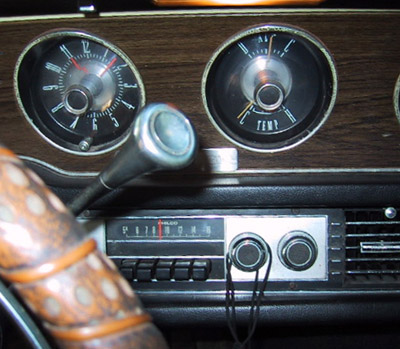
<- Back to the Degenerate Press Thunderbird page.
April 1, 2003: I'd gotten sick of hauling this car to the shop and having it tweaked, only to have it run like crap again three days later. The answer was consistently "Well, I adjusted the points and the timing a little..." Everyone on the Yahoo Glamorbird group raved about replacing points with electronic ignition so I called up Lincoln Parts International and ordered the Pertronics Electronic Ignition kit. Rumor has it even a mechanically ignorant novice like myself can do the switch in 10 minutes. I didn't even know what "points" looked like, but I was able to do the job. It only requires a pair of pliers to get the connections off the coil, and a flathead screwdriver to remove three screws. But in case you're mechanically ignorant like myself, here's some helpful hints and photos:
POOF - my problems are gone and it's been running great ever since. If I'd known it was gonna be that easy I'd have done it long ago, and all for under $100.
May 17, 2003: I got the correct radio bezel for the stereo model earlier in the week so I decided to swap out the AM radio with the AM/FM stereo I'd had for a while but never gotten around to installing. I posted a message on the Glamorbird mailing list about the wiring and got the following response from Dan Loftis:
I just replaced my orig. speakers to my orig. AM-FM Stereo radio w/ Infinity speakers. I chose them because they had the highest Sensitivity rating which means the input from our weak radio's amps will give you the most output. Someone said these radios might put out 10 watts so I was trying to get the most from new up-to-date speakers. The two front model #3052 are 3 1/2" speakers. I put them in the front center of the dash 4x10 opening. Don't know if you have wiring run to the front doors w/o standard speaker install so the center dash may be easier for you in wiring as well. In the rear are model #552, 5 1/4", 8 ohm.
You should have 5 wires coming out of one connector of the radio. These feed the speakers and should be Red, Blue, White, Orange and Black. Our speakers are wired in series (I think that's what you call it) Anyway, the Red ties to both the Front Driver Neg. speaker and Pos. Rear Drv. The Blue goes to both the Front Pass. Neg. and Pos. Rear Pass. The White is + (Pos.) to the Front Pass. side. The Orange is + (Pos.) to the Front Drv. side. The black is ground or Neg. for both of the rear speakers.
A word of warning on the rears. When you replace them, put some padding under them like rubber and DON'T tighten down the mounting screws all the way. The rear deck is NOT level and it will bend the speaker frame and distort the sound.
What he didn't mention was how to get the stereo itself into place. You should probably disconnect your battery before you do anything concerning electrical components. I neglected to do this the first time I messed around back there and in the process of all this I brushed against something and sparks flew, blowing out a fuse or two. (Later I found that the diagram in the owner's manual is upside down, or my fuse box was mounted upside down. Very confusing!)

To remove the AM model:
Remove the front panel/bezel from in front of the radio. It's attached with 6 screws that came out easily, but you don't have to take off the vent knobs, only the radio knobs. Once you work this panel out you can see a bolt that holds the radio in, as well as a nut on one of the shafts of the radio knobs.
Remove the panels under the dash. I found it's easiest to remove both of them, as well as pulling out the vent tubes to give you a view of everything.
There is another mounting bracket on back of the radio. Remove the bolt from the bottom of the dash and/or the nut from the back of the radio.
Push the radio straight back toward the engine so you can get to the rest of the wiring. Since the T-bird had dozens of options, which your car might not have, there are often wiring and vacuum lines hanging unconnected. So you might want to get some masking tape and a pen and make labels for the wires and/or connectors as you pull them off. If I remember right, there is a blue wire and a black wire that go into a connector. Then there's the big fat antenna wire in the back that plugs straight in to the back of the radio.
If I remember right, that's all there is to disconnecting the AM radio. However, getting the thing out of the dash is another issue entirely. I had to remove some tape from around a vent tube and disconnect the vent tube from behind the radio. Then you can push it straight back and down and squeeze it between the dash brackets underneath and the vent tubes behind. Getting the vent tube to slip back together was a real bitch, but otherwise it's a tedious but relatively easy task.
To install the FM model:
If you're smart, unlike me, you'll hook the thing up before you cram it into the dash and make sure the stereo and light both work. If you're not getting power, check your connections and the fuses (located in the glove box. See elsewhere on the Thunderbird page for notes on that.) Or maybe you disconnected the battery and forgot?
I wasn't able to get the thing put in the same way I pulled the AM model out. The stereo model is a little taller and doesn't want to squeeze between the vent tubes and dash brackets. I ended up taking the ignition panel off and disconnecting the ignition switch and ash tray light so I could get that whole assembly out of the way. Then I pulled out the vent tube assembly - the plastic two-hole piece that's attached to the front of the dash. Remove the two screws in front then pull the back of it down and out. Or carefully squeeze it a bit so it pulls out the front. Then you have a big hole to the right of where the stereo will sit. You can push the stereo up and in horizontal and sideways from behind into this hole, then rotate it into it's proper place. It wasn't easy. Later, when I did this a second time, I was able to disconnect the vent tube behind where the radio goes and push it up and into position that way - it's much easier.
Attach the front mounting bolt.
Roll around in your floorboard and scrape your knuckles all to hell so you can reach up behind and connect the antenna wire and the rear bracket and bolt.
If you had the AM-only radio you probably only have a the single dash-mounted speaker and none of the factory wiring and connections, so you should probably mount speakers and run the wires and such. With the ignition out of the way, you should have enough room to wire things together. I've found since then that it's not so bad to get into there once you've got the stereo in place. You only have to take out the front face and remove the vents to get to the wiring on the side of the stereo. To get to the light you have to remove all the bolts that hold in the stereo. You can then push it back enough to reach over the top and pull out the light. I replaced it, only to find it wasn't the bulb. I replaced the fuse (which is also the circuit for the lights in the ignition, ash tray, and behind the heater/vent controls), and suddenly I have lights all over the place I never had before. But then the next time I cranked up the car, they were all gone again. I have a short somewhere blowing that fuse. My mechanic suspects the headlight switch.
If you're like me, you're stumbling across lights in places you never knew about, like in the ignition and ash tray and under the dash. Some of these were missing bulbs and none of them worked. As I mentioned above, I should have checked the fuses, then the bulbs before I put everything back together again. But at least I have the stereo in place.
There is a two-prong plug with a black wire and a blue wire with a red stripe. This connects to the plug that should be hanging around in there. It's the power for your stereo and light.
If you have speakers installed, it's a fairly easy task to wire up the stereo. If your car had AM only, you don't have the factory wiring for the speakers so you'll have to either chop the plug off the stereo, or find a way to plug the speaker wires into the stereo's plugs. All the speaker negative wires go to the black. The other positive ones go to the other 4 wires in that plug.
Test everything. Try it with the car running as
well. I didn't. The stereo sounded fine when the engine was off, but
then I put everything back together and started it up. While the
engine is running, the stereo has a slight buzz or hum in the
background. I poked around and found this off the Yahoo Glamorbird
board as one possible cause:
"Right inboard of the fuel gauge is a piece of metal that is wrapped
in very thin bare wire. It is covered in cardboard. it almost reminds
me of a
homemade resistor (magnet). Does anyone have a clue what this is? I
can't locate it in the wiring diagrams or shop manual."
"That is a radio suppression coil and it should be hooked up to the
constant voltage regulator to filter out the static caused by that
regulator . Once the clock is removed from the instrument cluster you
will see the regulator. It is held in by a screw. Remove the screw and
unplug the regulator.
If this regulator is bad it will affect the fuel, temp, and oil
pressure gauge. Green Sales has them. The part number is: C7SZ10804A.
http://greensalescompany.com/"
(I've called them and the part is $35 + shipping - a bit much to spend
on a part I'm not entirely sure is broken.)
I've also been told this may be due to switching to electronic
ignition. "I had the the same problem when I installed a pertronix
ignition unit. I forgot to re-connect the radio suppression condenser
on the coil." I'm pretty sure I reconnected everything per the
Pertronix instructions, but they may have neglected to mention
this little twist in their instructions!
To get the vent assembly back in, push it through the front of the dash instead of trying to go in from behind.
Reinstall the ignition and ash tray assembly if you removed it.
Reinstall the dash radio bezel and the panel under the dash and rock on!
I have investigated how to install the speakers and I'm
amazed at how impossible a task this will be. If you didn't have
speakers in the rear originally there are still places for them to go,
but I don't see how the hell you're supposed to do it. The rear speakers
are mounted in the very corners under the rear deck, right on top of the
fenders.
To get to them, you have to pull out the back seats
so you can remove the rear deck, then pull off the rear windshield trim
so you can pull off the corner deck pieces. Remove some nasty insulation
and you can see the task that lies ahead of you.
Only 5 1/4" round speakers fit,
and I've been warned that the deck is actually curved there a bit, so to
keep from warping your speakers you should mount some rubber or
insulation of some kind between the speaker and the deck. What had me
boggled is A) how the hell do you get in there to hold the speaker in
place and get screws or bolts in there, and B) what kind of screws or
bolts are supposed to fit through the tiny tiny holes they've left
there? I was stumped.
I gave up and left the chore to my mechanic, hoping his far superior
knowledge and tools might help. He used self-tapping screws to get the
things into place, since no drill can fit in the space between the deck
and rear windshield, or deck and the tops of the fenders, to open up the
screw holes any wider.
To add to that, my car came with the AM-only radio with only the dash
speaker, no speakers in the front doors. The AM/FM stereo is set up for
4 speakers. Where am I gonna put the front speakers? I can't find the
proper proper arm rest panels with speaker grills so I can mount 'em in
the door where they belong (and my arm rests are sagging
and need to be replaced, which I also can't afford.) Ugh.
The AM/FM I got on ebay didn't work - bummer. But I had Nathan install the under-dash Radio Shack 8-Track player I got, still new in the box, off ebay. Now I rock out to the warbling, hissing sound of such 70's classics as The Edgar Winter Group and Jesus Christ Superstar. I'd forgotten what a crappy format 8-tracks really were. So now I want to get the bucket seats and console so I can use the console to hide a CD player, maybe keep the 8-track in there too just for the heck of it, and get the AM/FM replaced. If I came into some big money I'd have the AM/FM rebuilt by Tayman Electrical. But it'd have to be found money or something 'cause I don't wanna cough up $400 just to have the original radio look with modern radio guts.
A couple weeks later I got another AM/FM and installed it as mentioned above. Sounds pretty good. Then I wanted to install a switch so I could go from radio to 8 track player. I hit Radio Shack and got what I hoped was the right switch (remember when they used to have knowledgeable old guys working there instead of the high school dropout losers that work there now who's only job is to try to push cell phones?) and hooked everything up as I thought it should be. No luck. Tested the switch and it's the right one. Took everything apart and put it back together, just in case it was a loose connection or something. No luck. Messed with it all damn day with no luck before finally giving up. At least I was able to get the stereo working.
A couple weeks later I took the wiring apart for the radio/8 track and redid everything. Still no luck with the 8 track. So I hooked the 8 track player straight to the battery to test it and make sure the unit itself wasn't the problem. Nope, it worked fine. So I started from scratch again and found I'd done something backwards in there somewhere and now everything works as it should, except that when the 8 track is attached to the dash it causes the stereo to cut down to about 1/4 volume. Apparently they don't like sharing a ground or something. I'm ignorant in electronic matters (as if you hadn't figured that out already) so instead of trying to solve that problem I built a little wooden console that fits over the transmission hump and mounted the 8 track player in that. Now I can rock out with the best of 70's rock on 8 track, or switch over to AM/FM stereo. I still have the buzz in both the radio and the 8 track, possibly due to the radio suppression coil. I ordered the part from http://greensalescompany.com/ and it doesn't look like the part described by people who've had the same problem.
When I replaced the bench interior with buckets and a console, there was no place for the 8-track. Which was fine as I was sick of it anyhow. So I removed it but that didn't help the buzz. According to a post on the Yahoo Glamorbird group: Napa Auto Parts sells an item just for noise suppression. You hard wire it right into your ignition. It has a very healthy and fat cap that does the job for you. Solid copper ignition wires of old days, gives you incredible noise without suppression. Also, look at your Alternator, and see if it also has a Cap on the rear of it running to ground. If not add one. You might also check into Summit or some other Hi-Performance catalogue and see if they offer coils with built in suppression.
This is a dirty, tedious job but it's pretty simple. Even a mechanically ignorant idiot can handle it, but there are a few minor tricks I wish I'd known before I started. Here's the blow-by-blow:
You'll need a star socket tool to remove the shoulder seatbelt. That's the only special tool you'll need. A phillips head screwdriver and a flat head screwdriver are the only other tools you'll need.
The hooks sometimes used to hang clothes and the shoulder seatbelts have little plastic sleeves on them. Slip these off with a little work, then just unscrew the screw.
Remove the trim around the ceiling. Remove the piece along the top of the windshield and rear window. Remove the pillar trim on either side of the windshield. I didn't have to remove the vertical panel covering the center post/pillar, which is good because I couldn't figure out how the thing is attached. I suspect there's some screws behind the stainless steel or aluminum piece of trim near the bottom, but I managed to get the headliner out without having to remove it anyhow.
Remove the visors. They're held in by three screws. Then they just pull out easily.
Remove the rear light lens/cover. I've seen two versions of this light (I suspect a difference between 2 and 4 door models, but I'm not sure.) On my car, the lens pops loose. It's a tricky job, but if you twist it a bit sometimes it starts to pop loose, then you can pry it the rest of the way off. Remove the light bulb. Behind the light bulb is a screw that holds the panel in place. I didn't remove the rear deck lid pieces in the corners, but I probably should have because when I went to tug the vertical panels out I cracked the panels at the bottom where they tuck behind the deck panels. You might be able to do this carefully with more finesse than I used, or you might want to admit defeat and remove the rear deck corner pieces first. Of course, to do this you have to remove the whole *&^%$ back seat...
You're ready to start on the headliner! Use a flathead screwdriver (or if you have one, a staple remover) to pry the staples off that hold it to the cardboard around the edges. If you're replacing the headliner as it was installed, you'll want to leave the cardboard backing in place so you'll have something to staple the new headliner to. As you start pulling the staples the headliner comes loose, exposing a view of the insulation and headliner rods behind it.
I started at the back, which turned out to be the right decision. There is a pair of wire hooks that hold one of the headliner rods in place right above the rear window. I wouldn't have seen these had I started from the front.
Getting the headliner rods out is tricky. They're just stuck in holes at either end. I twisted it so that it bowed downward instead of up towards the roof, then pulled on one end until it popped free. Then the other end popped loose easily. These are color-coded so you'll know which one goes where when putting them back in. I don't have it on me, but the colors and locations are mentioned in the shop manual. (Or you could put some masking tape on the end of each one and label them as you pull them out.) I left mine inside the headliner as I removed it so I wouldn't have to worry about it, then labeled them with tape and a marker once I got the whole mess out.
Around the edges of the ceiling the headliner is squeezed between the rubber and the steel. I don't think it's glued in there, or if it is the glue on mine had long since lost it's hold so it was easy to pull the headliner free without having to remove the door rubber/seals. It was also easy to pull it out from behind the post trim/panel. I suspect that installing a new one would require removing the vertical piece of trim so you could get the material back behind it to help hold it in place, but I didn't install a correct replacement, as you'll see, so I didn't have to deal with that.
Once you have the headliner out you can inspect the roof/ceiling insulation. Mine had some water damage and rot and I'd rather just replace it while I'm in there, so I scraped it off. This is the dirty part of the job. The paper/cardboard backing had rotted and sticks to the ceiling instead of the insulation as you pull the insulation free. Scraping off the remnants makes a huge mess. I wanted to remove the headliner both to replace it, and to search for a pesky water leak I have. Since I wasn't sure if I'd have a bunch of rust holes in the roof, I didn't even have a replacement headliner when I started this job. I have a little surface rust and it looks like water gets in somewhere, but I can't find where. The rails along the ceiling make it difficult to see down in the crevice behind them but there's only a little bit of rust here and there.
A few days after I removed the headliner, I found the rust treatment paint I wanted (a Rustoleum product, chemically bonds with rust, good stuff) and painted the rusty spots and pushed the brush down behind the rails all the way around the ceiling. I still have leaks that come in at the top of the windshield.
Got this feedback from someone on the
Yahoo
Glamorbird Group:
"Went through this job last summer. For repairing of Headliner Boards,
check John Draxler's site at
Thunderbird Ranch under Technical Stuff-Headliner replacement on
cars with Molded Panel. Works great."
I got the insulation online somewhere, double-sided stuff and a can of spray glue. The only tools you'll need are scissors and a tape measure, though you may want to remove the interior ceiling trim before you start (see above.)
Scrape off any old insulation as above.
Measure the sections between the roof rails and supports. Cut the insulation to fit and double-check that your pieces fit before you start spraying glue on things.
Follow the glue instructions. The type I got said spray both surfaces and allow it to become tacky. It was a warm, sunny day and the roof of the car was already hot so the glue became tacky instantly. I put a tarp over the seats in case the glue dripped, which it did once or twice. I was impressed with how easy the stuff was to apply, but once it's tacky it's very sticky so you need to make sure to put your pieces in carefully. I started at the front edge and worked back, rather than go side to side. This helps prevent things from getting crooked.
I saw a web site somewhere where the guy had customized his wagon and replaced the headliner with interesting fabric. He had decided to put the headliner rods beneath of the fabric instead of behind, both because it's a heck of a lot easier to do, and to incorporate the rods into the ceiling as a decorative element. I thought it looked great and my old headliner was shot, so I found cabana mats online and decided to go with those so it would give the interior a tiki hut feel.
Obviously, you have to start by pulling out all the interior trim, seatbelts, etc. as above.
I laid out the old headliner next to the cabana mats I was going to use to replace it, just to size things up. I pulled the old headliner onto the mat and confirmed one 4'x6' mat wouldn't do the job, so I cut one of the mats to fit, leaving plenty of extra on all sides.
I started by using the windshield vertical trim to hold one edge in place. Unfortunately, I didn't leave any excess sticking out the side, only the front. I should've given myself some extra on both edges. In addition, the edges of the cabana mat have a hem that makes it two or three times as thick, so the edge doesn't tuck behind the trim as easily. But by the time I discovered this mistake I was too far into the job to take it all apart, and had already trimmed the opposite side too close to pull the whole thing over anyhow. It all worked out, but I should have done both sides as I did the driver's side - with plenty of excess. Another thing I wish I'd done was spraymount some fabric to the back of the mat. There are tiny holes between intersections in the slats in several places where you can see through to the roof or insulation behind it. I don't know that anyone else will notice this but me, but any thin, cheap, tan or black stuff would've done.
I put in the first headliner rod. I slipped the tips in between a couple of the slats in the mat when I could. For other rods, I just had to poke a hole straight through the slats themselves.
I poked a hole through where the visors go so I wouldn't have to pull things apart again to find it later. Then I decided to go head and put in the visors. It's easy to do now when you can pull things aside to find screw holes and such, and they help hold everything in place. In fact, as you go, find all the things that have to go through the headliner before you get the whole thing in place and can't see the screw holes. If you start at the front, go ahead and put in the screws for the visor holder. Don't forget to put in the components that go through the headliner as you go, such as the seatbelt shoulder harness. I forgot the clothes hangar seatbelt hook things and later couldn't located the screw holes for 'em!
Put on the top windshield trim and the visor holder. That holds everything in place up front and you're ready to start working back.
Put in the headliner rods one by one.
One 4'x6' mat covers about 3/4 of the ceiling. I tried to set things up so it ended near a headliner rod, which worked out pretty well. This way, the next mat can slide behind the first and the overlap is held in place by the rod. Now you're ready to get started on the second mat covering the rear of the ceiling. It's a lot more complicated.
I started by tossing the mat over the roof and cutting out the excess so it would be easier to work with. I gave it enough overlap so that the rear mat is tucked behind the front mat and two headliner rods, just to make sure things wouldn't slip around as I worked, or fall out after everything was done. However, I didn't give myself enough excess at the back corners so later I had to go back and re-weave in some slats to cover a few gaps. There was enough mat to do it, I just trimmed a bit too much off.
Put the second mat in place.
Put more rods in place. I cut more excess off so I could see what I was doing.
I decided to cover half the vertical cardboard pillar panels and use the rear interior light trim as the divider between tiki roof and black interior. (That's when I discovered I'd trimmed a bit too much excess on that first cut outside the car and the mat didn't quite reach all the way down into the corner. Later I wove some scraps in to fill the gaps and it looks ok, but it would've been a lot less work if I'd done it right the first time. Also, it would've been easier with the rear deck out, but I didn't want to pull the rear seat out to do that. In retrospect, I would've had more room to work as well had I done that!) Anyhow, I took the interior light trim off the pillar panel and slid the cardboard panel behind the mat and trimmed the excess so I could see the hole for the light.
I mounted the interior light trim back onto the wall without it's little nut that holds it to the cardboard piece. It seems to hold fine with just the screw that goes in behind the lightbulb. Once everything was together I decided I'd made the right choice and it looks good coming down to meet the interior light trim.
I put the rear windshield trim back on, trimming up the excess as I went, as well as the side trim and other pieces I've neglected to mention.
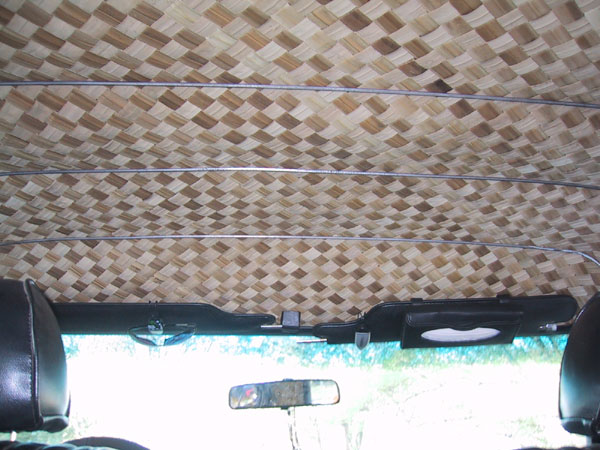
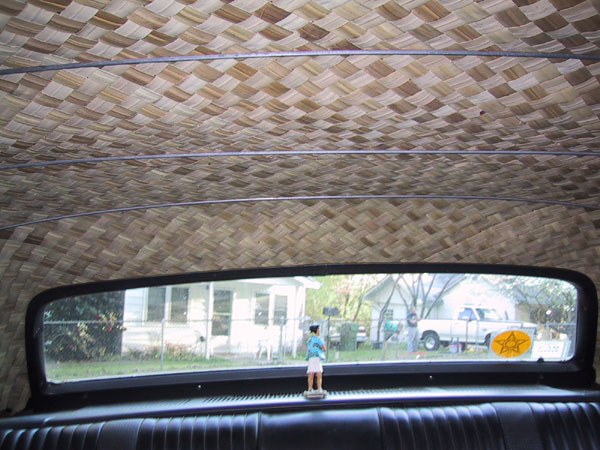
The next day I got some scraps together and slid them into the weave to cover up the gaps I'd left, putting a little wood glue on the back of the slats before I slid them in to help hold them in place.
A few months later I bought some 1/2" bamboo and split it and used it to cover the headliner rods. Now it has a true cabana ceiling look.
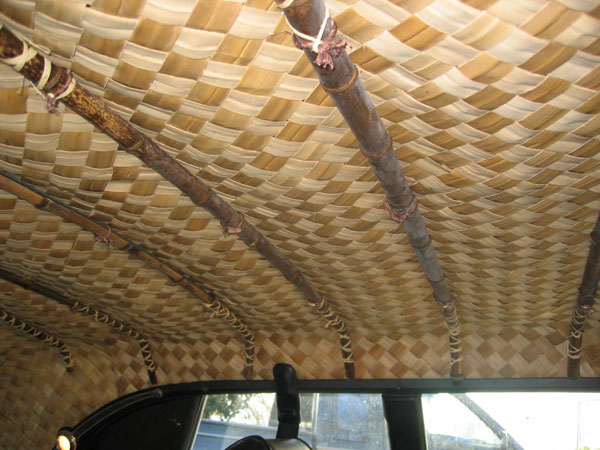
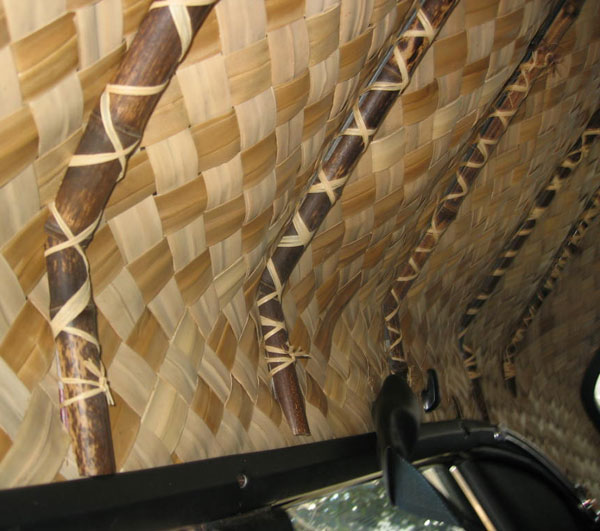
I think it looks great. There are a few gaps in the corners above the rear deck that still need a bit of work, but I may have to pull it all out when I go to get the roof leaks fixed, so I'm ignoring them for now.
I picked up a replacement unit with updated electronics from Cougars Unlimited off ebay. I'd been looking at these for a while but my tail lights worked ok (one side had two lights that came on simultaneously, but otherwise they functioned normally.) But the lights are dim and they don't always blink when the engine was at low idle. People who had done this replacement said the tail lights were a bit brighter and the new unit could handle brighter bulbs than the old one. So when I got some birthday money I went for the replacement. Use the links below to see pictures.
The sequential unit is behind the rear seat in the trunk compartment. I've removed the seats in this car a dozen times or so for one reason or another so I decided to go that route instead of clambering around in the trunk. When you remove the seats it's easy to find the unit. I found it easiest to remove the housing from the body as well. Then it's a simple job to use a flat head screwdriver to pop open the box. Be careful though, that's almost 40 year old plastic you're handling.
The old unit is attached to a couple of plugs. They're not easy to pull apart but after a lot of wiggling and prying I got them loose. The new unit was a breeze to put in. I didn't put everything back together immediately though. I've learned my lesson too many times - always wait until you've confirmed it works before putting anything back together, when possible!
The instructions said the flasher can was in a compartment above the glove box. So I looked around in the glove box and didn't find a way to get in there without taking the glove box out. The problem is the screws holding the glove box in don't allow for a screwdriver any longer than about 2". I finally found a phillips head drill bit and a pair of pliers did the job. Once I did that I still couldn't find the thing. After rolling around in the floorboard for a while I spotted it - next to the glove box. I wouldn't have had to take the glove box out at all had I known where to look! The flasher comes off and is replaced with one that came with the kit.
Poof, job done. My tail lights are definitely a little brighter. Before. After. They also blink sequentially, consistently, regardless of engine speed. Worth $100? Probably not. But soon I'll get a set of brighter bulbs for the car and hopefully the road hogs in SUV's on cell phones will be a bit more likely to notice when I'm stopping or turning...
I got an NOS clock off ebay, since mine only worked for a few seconds at a time and I've heard they don't survive the years of non-stop running. So when it arrived I figured this was an easy swap, but when I pulled the panel off from in front of the gauges I was confused. Eventually I gave up and asked for advice from the Yahoo Glamorbird group. It turned out to be much easier than I'd thought. Here's the step-by-step:
Once my clock was in, the hands moved as they should but it would not allow me to adjust the time. I fiddled with it until I decided it's just broken. I can feel the gears inside it popping and slipping and the minute had twitches, but will not move. Argh!
Rather than struggle with finding the headlight vacuum motors and/or paying for them to be rebuilt and having that whole system worked on - just so my headlight doors would open and close - I decided to do what other hotrod types have done and have the headlights shine through the grill. I think I took photos of this process, but I can't seem to find them now and it's been some time between when I did it and when I wrote this, so I'm writing this from memory, without even looking at the car.
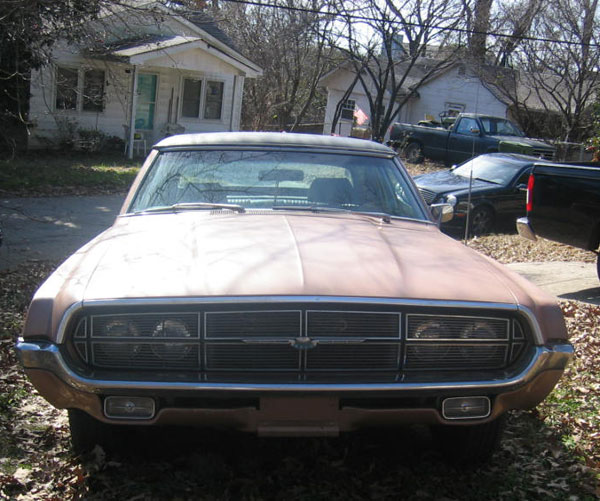

I replaced the headlight bulbs with a supposedly brighter set. Everything seems bright enough, so I'm happy with the job and would recommend it to anyone who wants the grill to look like it should, with the doors closed, but can't afford to have the vacuum motors rebuilt and a mess of vacuum lines replaced.
I took one of the best grill emblems I could find (I think I have three from the various parts cars I've looted over the years) and did some restoration work on it. I cleaned all the reflective paint off the back of the plastic "gem" inserts, then recovered them with fresh chrome paint, masking off the rest of the part so I didn't get any paint on it. Then I took a fine brush and some gloss black paint and redid the paint on the front. It's not good-as-new, but it's a heck of a lot better that it was.
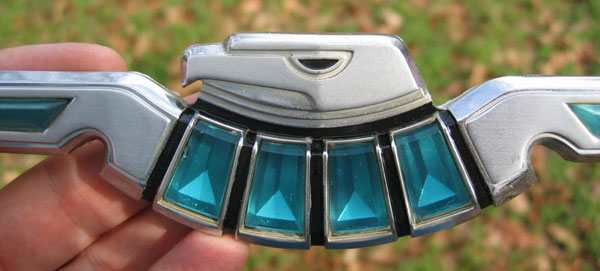
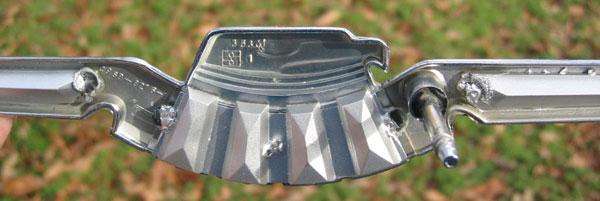
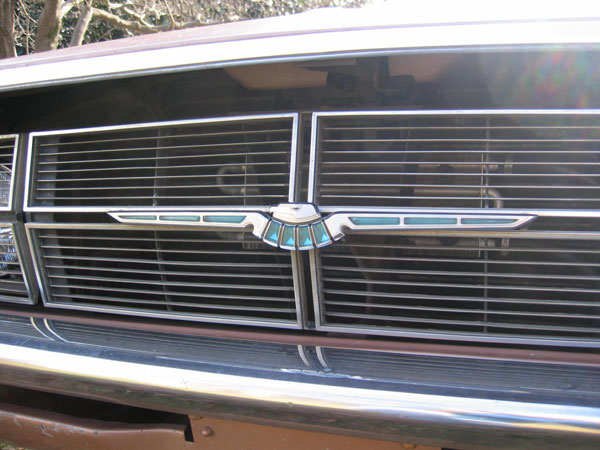
<- Back to the Degenerate Press Thunderbird page.
 |
"These people could put us out of
business!" Take
me to Degenerate Press' home page! All content on this site is owned by Degenerate Press and cannot be used without our permission. We have lawyers for friends with nothing better to do than cause trouble (no kidding), so play nice. Copyright © 2009, All Rights Reserved |